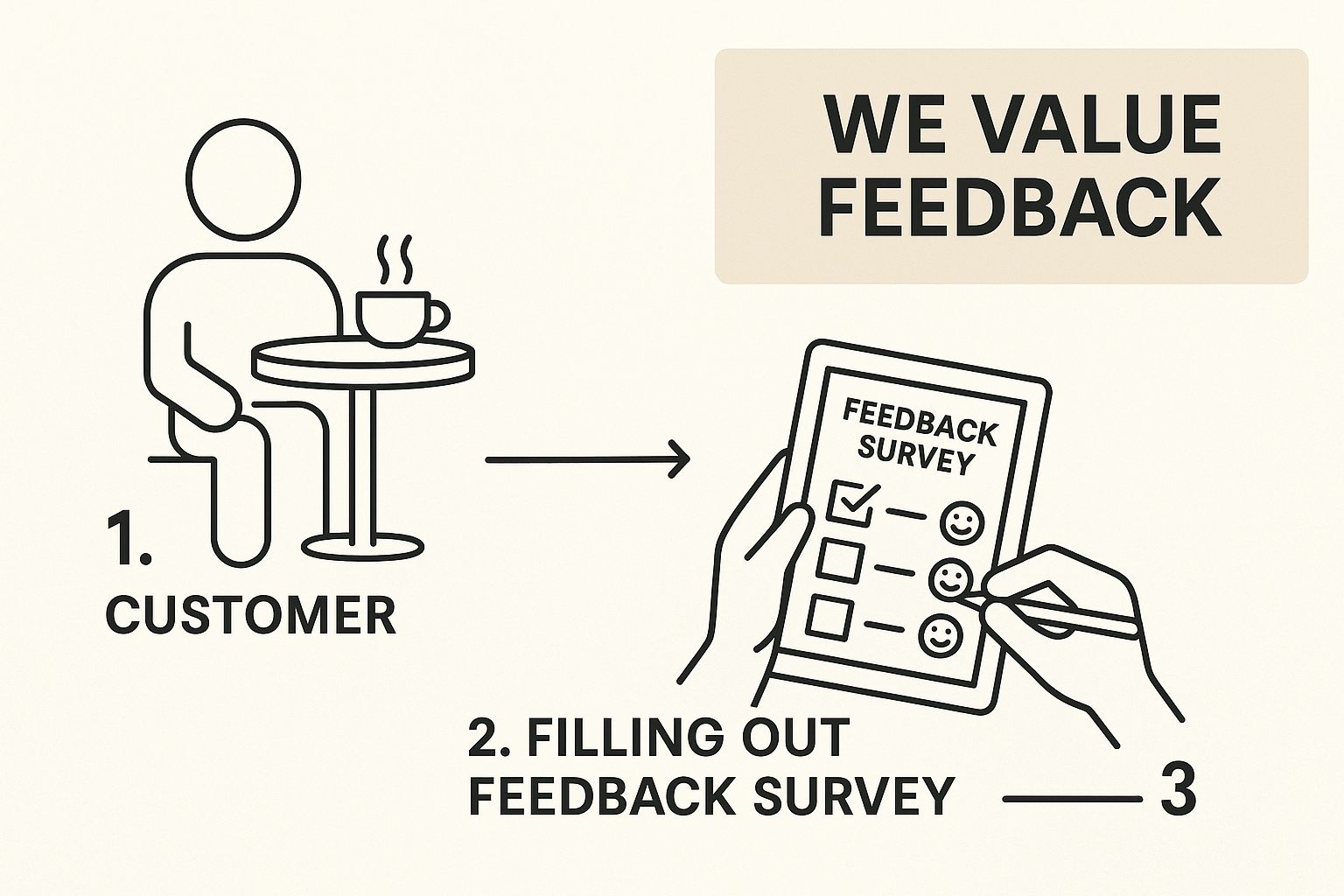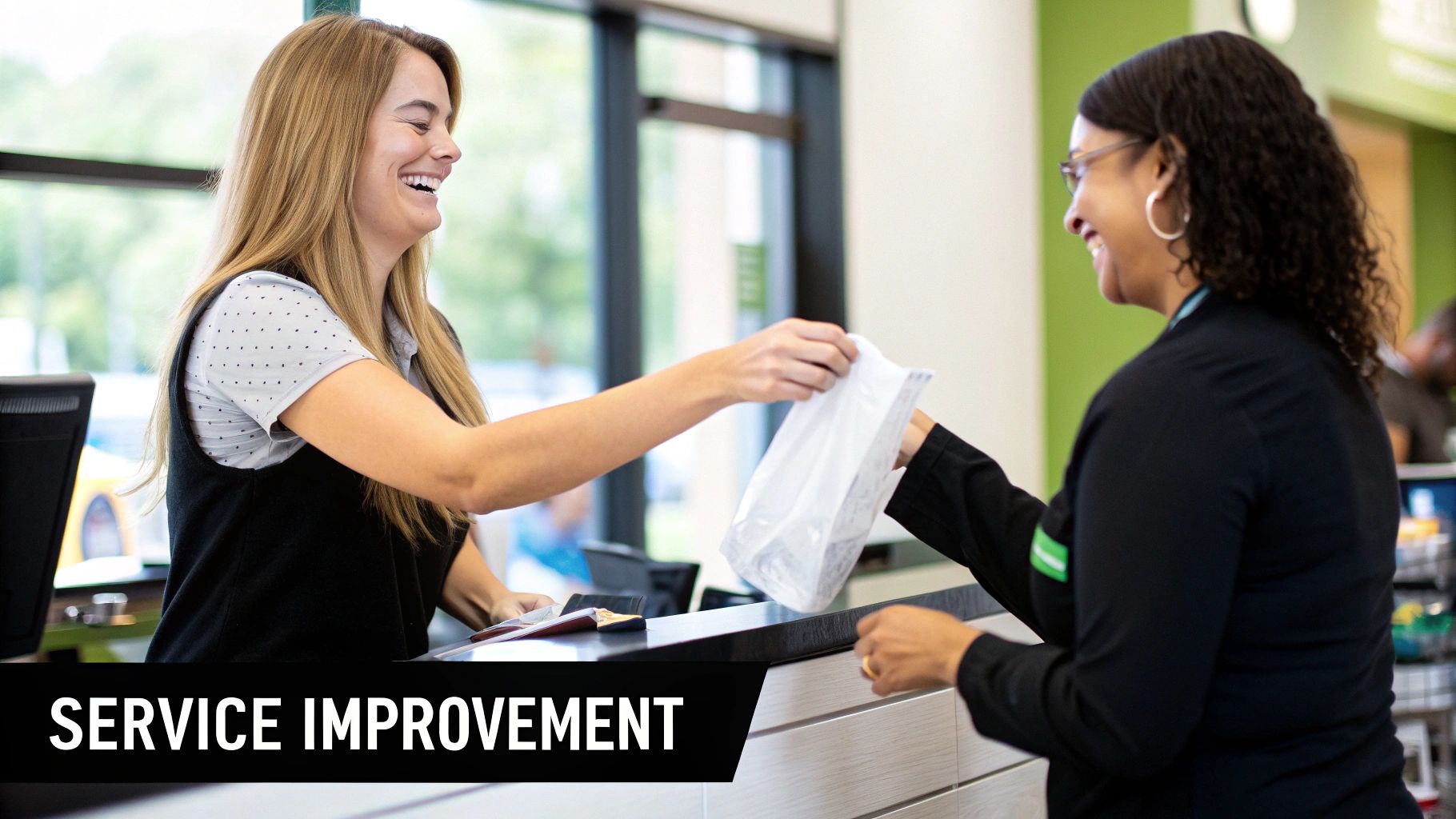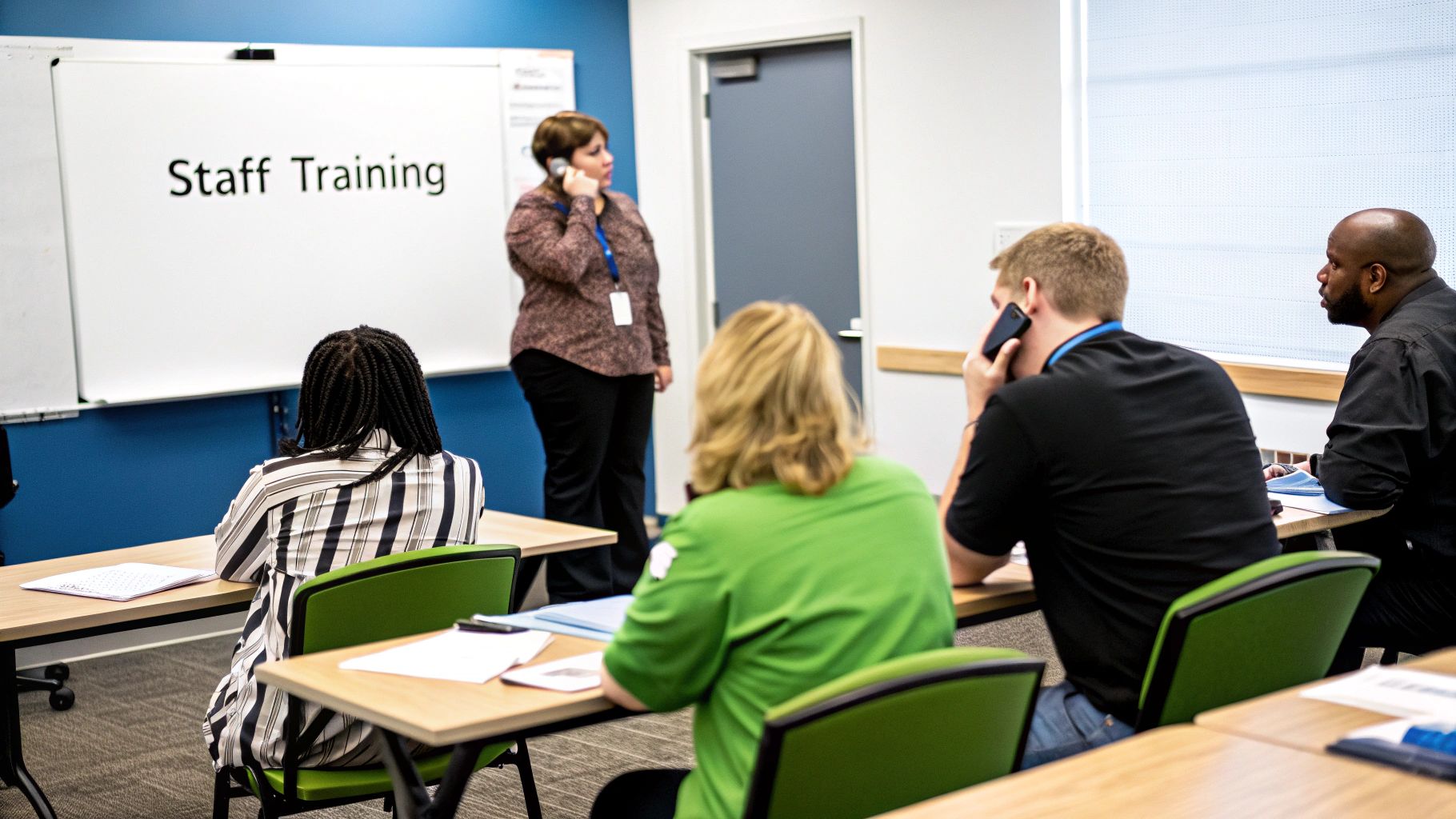Customer satisfaction isn't just a nice-to-have metric you glance at once a quarter. It's a deliberate, structured process that directly feeds into repeat business, powerful referrals, and a stronger position in your market. The real goal is to move from leaving great experiences to chance and start making them a predictable, measurable part of your sales DNA.
Why Customer Satisfaction Is Your Growth Engine
Think about one of your field sales reps facing a particularly tough client. That single interaction—how they listen, respond, and solve a problem right there on the spot—is a make-or-break moment. It can either create a long-term advocate for your brand or send a valuable account running to a competitor.
That moment gets to the heart of a fundamental truth in field sales: customer satisfaction is no accident. It’s the engine that powers sustainable growth.
Exceptional customer experiences are what separate the businesses that thrive from those that are constantly scrambling to keep up. When your customers genuinely feel heard, understood, and valued, the positive effects ripple through your entire operation.
- Drives Repeat Business: It's simple. A satisfied client is far more likely to come back for more.
- Generates Valuable Referrals: Happy customers become your best salespeople, eagerly sharing their positive experiences within their networks.
- Strengthens Your Market Position: A reputation for outstanding service is a competitive advantage that’s incredibly difficult for others to copy.
The secret is to get out of the guesswork game. To truly move the needle, you need to understand and actively work on specific strategies to improve customer satisfaction scores.
From Metric to Mindset
Treating customer satisfaction as just another number on a dashboard is a massive missed opportunity. In reality, it’s a direct reflection of how well your team delivers on your brand’s promise.
This focus is becoming even more critical in regions experiencing a shift toward service-based employment, like we're seeing in the Caribbean. As labour markets evolve, the urgency for better customer experience approaches grows. You can find detailed insights into the growing importance of CXM in the Caribbean.
In the world of field sales, the days of the one-size-fits-all pitch are long gone. If you want to build relationships that actually last, you have to move beyond just using a client's first name in an email. True customer satisfaction comes from showing up to a meeting already armed with a deep understanding of their business, their history with your company, and what they're trying to achieve.
When you do your homework, the entire dynamic shifts. You're no longer just a salesperson; you become a strategic partner. Before your reps even walk through the client's door, they should be digging into recent company news, looking for cues on social media, and, most importantly, reviewing the client's complete interaction history.
This is all about listening and learning before you ever say a word. As you can see below, collecting and acting on feedback is the cornerstone of this entire process.

Making it simple for customers to share their thoughts is the first step. The real magic, though, happens when you use that information to create a genuinely personalized experience.
Don't Just Scratch the Surface
Real personalization means connecting the dots between past interactions and future opportunities. Think about it: a sales rep who can bring up a support ticket from six months ago and ask, "Was that issue ever fully resolved for your team?" shows they're invested in the entire customer journey, not just closing the next deal.
This is where having all your customer data in one place becomes a massive advantage. When a field rep can pull up a complete 360-degree view of the customer on a mobile tool like LeadFlow Manager, they walk into that meeting ready to add real, tangible value.
To make this practical, here’s a breakdown of how your team can apply personalization at every touchpoint using a mobile CRM.
Personalization Tactics Before During and After a Sales Visit
table block not supported
Embedding these small, personalized actions into your sales cycle transforms you from a simple vendor into an indispensable partner.
Tailor Your Approach to Cultural Expectations
Personalization isn't just about data; it’s also about people and their local expectations. In some markets, a more direct, human connection isn't just nice to have—it's non-negotiable.
This is especially true for businesses operating in diverse regions. For example, companies in the Caribbean often find that customer satisfaction hinges on experiences adapted to local cultural norms. These norms favour a much more personal touch than is common in North American or European markets. According to some great insights from Caribbean customer service experts, success there often comes from using direct chats and video calls with real people and guaranteeing callbacks within minutes.
The principle holds true everywhere: truly knowing your customer means understanding how they prefer to communicate. By weaving these deeper personalization tactics into every stage of your sales process, you're not just selling a product—you're building a partnership. It's a powerful strategy that pays dividends in long-term customer satisfaction and loyalty.
Streamline Your Field Operations for a Flawless Experience
Behind every great customer experience is a smooth, well-organized process. Think about it: a clunky or chaotic field operation is a silent killer of customer satisfaction. It creates friction and frustration that can completely undermine even the most polished sales pitch. Your brand’s reliability isn't just about what you sell; it's about how professionally your team operates in the field.
When a sales rep shows up exactly on time, it builds trust from the very first minute. That’s not luck—it’s the direct result of smart operational planning.
Master Your Team's Time and Territory
Efficient route planning is really the cornerstone of operational excellence. When your reps aren’t wasting time zigzagging across their territory, they arrive at appointments feeling relaxed, prepared, and punctual. This simple act of respecting the customer's time sets a positive tone for the entire meeting.
Optimizing routes also means your team can pack more quality visits into their day without feeling rushed. This allows them to give each customer the attention they truly deserve. LeadFlow Manager helps with this by mapping out the most efficient daily routes, turning punctuality into a consistent part of your brand promise.
Eliminate Friction From the Sales Process
Nothing sours a promising conversation faster than a logistical hiccup. Imagine your rep closes a great deal, only to tell the customer the product they just agreed to buy is out of stock, or that the paperwork will have to be processed "back at the office." These delays create doubt and make your whole operation look unprofessional.
To really move the needle on customer satisfaction, you have to iron out these points of friction. This means giving your team the tools they need to close the loop right then and there.
- Real-Time Inventory Access: Give your reps mobile access to see exactly what’s in stock. This avoids the disappointment of promising an unavailable item and shows your company has its act together.
- Instant Order Processing: Let reps create and submit orders directly from their phone or tablet while they're still with the customer. That kind of speed and efficiency is impressive and very reassuring.
- On-the-Spot Invoicing: The ability to generate an invoice or take a payment immediately closes the deal cleanly and professionally, leaving no loose ends to worry about.
By focusing on these operational details, you're directly investing in how customers perceive your brand. A powerful CRM is essential for bringing all these pieces together. For a deeper look, check out our guide on how a CRM for field service can enhance your operations today. Using a dedicated platform transforms your field team from a group of individual reps into a coordinated, efficient force that consistently delivers a flawless customer experience.
Empower Your Team with Data-Driven Insights

If you really want to improve customer satisfaction, your team needs to stop just putting out fires and start preventing them. The key to making that switch is right there in your field data. Every piece of information—visit notes, direct feedback, even how long a sales cycle takes—is a clue that can help you get ahead of issues before they blow up.
As a manager, you can use this constant flow of information to spot trends, flag accounts that might be at risk, and offer targeted coaching that actually helps your reps improve.
Turning Data Into Actionable Coaching
Let's get practical. Imagine you're looking at your dashboard in LeadFlow Manager and notice one rep’s visits to a specific client are consistently running long. This isn't automatically a red flag; it's a signal. Instead of waiting for a complaint to roll in, you can reach out to the rep and find out what's really going on. Are there hidden challenges? Or maybe a new opportunity is brewing?
This data-first approach turns raw numbers into genuine teachable moments. It helps build a culture where information is used to support and develop your people, not just to watch over their shoulders.
The ripple effect goes far beyond just one account. Focusing relentlessly on the customer experience can drive major market growth. Take the Caribbean tourism sector, for example. An analysis showed a clear link between high customer satisfaction and a massive surge in cruise passenger numbers. The industry, now projecting 37.7 million passengers, saw 31% of cruisers in the past two years being first-timers—a boom credited largely to excellent customer experiences.
Key Metrics to Monitor for Satisfaction Insights
To get these kinds of insights, you need to know what to look for. Understanding how to quantify satisfaction is the first step. You can explore some proven ways to measure customer satisfaction to get a solid framework in place.
From my experience, these are the essential field sales metrics you should start tracking:
- Visit Duration vs. Outcome: Are longer meetings actually leading to bigger deals, or are they a sign of unresolved problems? Look for the patterns that connect time spent with real results.
- Follow-Up Frequency: How often are reps checking in with clients after a visit? Consistent and meaningful follow-ups are a huge sign of a healthy relationship.
- Customer Feedback Scores (CSAT/NPS): It's easy to add simple satisfaction surveys after a visit. Tracking these scores over time gives you a clear report card on how your efforts are landing.
- Sales Cycle Length: If it suddenly starts taking longer to close a deal with an existing client, that can be an early warning sign of dissatisfaction or a new roadblock.
By keeping a close eye on these data points, you can quickly see where reps are knocking it out of the park and where they might need a bit more support or training. This proactive, data-driven coaching ensures every person on your team is ready to deliver an experience that doesn't just satisfy customers, but turns them into your biggest fans.
Mastering Post-Visit Follow-Up and Feedback

The sales conversation doesn’t truly end when your rep walks out the door. From my experience, what happens right after the visit is often what separates a one-time sale from a lasting partnership. A solid, thoughtful follow-up process is your secret weapon for cementing customer satisfaction.
It’s all about showing that you value the relationship beyond just the initial transaction. This is your chance to reinforce the positive experience your team worked so hard to create. A prompt, relevant follow-up proves your team is professional, organized, and genuinely invested in the customer's success. It can make all the difference in their confidence in your brand.
Without a system in place, promises get forgotten and crucial details fall through the cracks. Customers start to feel neglected. But get this right, and you can turn a good interaction into an exceptional one, paving the way for future business.
The Anatomy of an Effective Follow-Up
Look, a powerful follow-up is much more than a quick "thanks for your time" email. It's a strategic touchpoint meant to add real value and keep the momentum going. Every single follow-up should be fast—ideally within 24 hours—and have a clear purpose.
An effective post-visit process really boils down to a few key things:
- A Quick Summary: Send a brief email that recaps the main discussion points and any action items. This simple step confirms everyone is on the same page and shows you were listening.
- Booking the Next Touchpoint: Whether it’s another meeting, a quick check-in call, or a product demo, get the next step in the calendar. This is how you keep the relationship moving forward.
- Asking for Real Feedback: This is the most important part. Ditch the generic surveys and ask specific questions tied to the visit's goals. That's how you uncover what really matters.
If you're looking for some great templates to get you started, check out our guide on 6 follow-up email samples for field sales.
Creating a Powerful Feedback Loop
Let's be honest: generic feedback requests get generic, unhelpful answers. If you want valuable information, your team has to ask pointed questions. For instance, if the goal of the visit was to introduce a new product, don't just ask "How was the meeting?". Instead, try: "How clearly did we explain the benefits of the new X-Series for your daily operations?" See the difference?
This is where having the right tool is a game-changer. With something like LeadFlow Manager, your reps can get automated follow-up reminders so nothing ever slips through. Even better, they can log customer feedback directly into the client’s profile while they're still in the field.
Turning Satisfied Customers into Loyal Advocates
When you nail both deep personalization and flawless field operations, you’re creating an experience that's pretty tough for competitors to beat. But the real magic happens when you layer on data-driven coaching and proactive follow-up.
Suddenly, the goal isn't just to keep clients satisfied; it’s to consistently delight them. This is the secret to transforming happy customers into your most powerful marketing asset: vocal brand advocates. Their loyalty is earned with every on-time visit, every insightful conversation, and every seamless interaction.
Getting there doesn’t happen by accident, though. It requires a clear strategy. As a manager, you can start by asking yourself a few honest questions about your current process:
- Personalization: Are my reps actually digging into a client's history before walking in the door?
- Operations: Are we running the smartest routes possible? Are orders being processed on the spot, or is there a delay?
- Feedback: Do we have a reliable way to capture what customers are saying and, more importantly, act on it?
True advocacy is the ultimate measure of success, and it’s built on a foundation of consistent excellence. It’s also a massive piece of the puzzle when it comes to understanding what customer retention is and why it matters for growth. By focusing on these core areas, you create a powerful engine for sustainable success.
A Few Common Questions Answered
Still have some questions about boosting customer satisfaction for your field sales team? Let's tackle a few of the most common ones we hear.
What’s the Single Most Important Factor for Customer Satisfaction?
If I had to boil it all down to one thing, it would be proactive personalization. This is so much more than just remembering a client's name. It's about your reps walking into a meeting already knowing that client’s history, their recent pain points, and what they’re trying to achieve.
When your team can access this kind of data on the go, their conversations instantly become more relevant and valuable. They’re not just reciting a generic script. That level of preparation builds a huge amount of trust and shows you’ve done your homework—a small detail that makes a massive difference.
How Can I Actually Measure Customer Satisfaction?
For a team that’s always out in the field, you need a blend of hard numbers and real-world feedback. Sending out a simple Net Promoter Score (NPS) or Customer Satisfaction (CSAT) survey after a big meeting gives you a solid benchmark to track over time.
How Long Does It Take to See a Real Difference?
You'll probably start to see small, positive signs—what I call leading indicators—pretty quickly. Think smoother client meetings or a few pieces of great anecdotal feedback. These little wins often pop up within the first month and show you're moving in the right direction.
But for the big-picture metrics like customer retention, referral rates, or a higher average order value, you need to be a bit more patient. Those shifts usually become clear after one or two full sales quarters. The key here is consistency. Lasting improvements in customer satisfaction are built over time, but the payoff is absolutely worth the effort.
Ready to help your field sales team build stronger relationships and delight your customers? See how LeadFlow Manager can bring your data together, simplify your processes, and empower your team on the ground. Discover LeadFlow Manager today.
